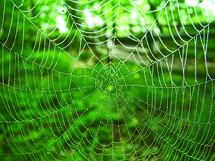

 We have had a number of articles on spiders over the years, with special attention being given to how they produce and use their webs. In Nature (February 2, 2012) is an article by Markus J. Buehler of M.I.T. concerning new research on the webs of common European garden spiders (Araneus diadematus) and the fact that their webs react differently to different kinds of stress.
We have had a number of articles on spiders over the years, with special attention being given to how they produce and use their webs. In Nature (February 2, 2012) is an article by Markus J. Buehler of M.I.T. concerning new research on the webs of common European garden spiders (Araneus diadematus) and the fact that their webs react differently to different kinds of stress.
In a light wind the material that makes up the web softens allowing it to lengthen but retain its overall structure. When the same web material has a larger force applied at a specific point the web becomes stiffer and breaks but only the most extended silk threads become severed. When this happens the web as a whole becomes stronger. When a tenth of the threads were removed, for example, the structure could carry up to ten percent more weight. That makes the material superior to steel that just shatters when similar conditions exist.
These properties are well-designed for the spider catching its prey. When an insect hits a web it will not bounce out because the web softens and stretches under the impact. Engineers are interested in copying this ability so that structures that are impacted in a storm could sustain some damage without the whole structure being compromised. There are even applications in the Internet where a local node would be sacrificed during an attack to keep the whole system from going down. Carbon nanotubes, carbon molecular structures used in carbon-fiber golf clubs and baseball bats, may lend themselves to copying the spider’s techniques. Once again we see man copying something in nature to make a superior structure for his own use. Velcro came about that way as have a number of common materials. God’s design in living things is always complex, but once we understand it, the applications are massive.
Picture credits:
© Michael Shake. Image from BigStockPhoto.com
